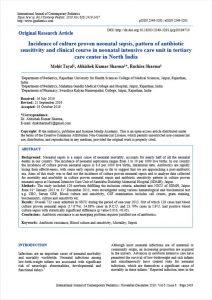
Background
Neonatal sepsis is a major cause of neonatal mortality, accounts for nearly half of all the neonatal deaths in our country. The incidence of neonatal septicemia ranges from 1 to 10 per 1000 live births. In our country the incidence of culture proven neonatal sepsis is 8.6 per 1000 live births, intramural data. Antibiotics are rapidly losing their effectiveness, with some early reports going so far to suggest that we are approaching a post-antibiotic era. The aim of this study was to find out the incidence of culture proven neonatal sepsis and to analyze data collected for mortality and morbidity in culture proven neonatal sepsis and antibiotic sensitivity pattern in culture proven neonatal sepsis at Neonatal Intensive Care Unit of Santokba Durlabhji Memorial Hospital (SDMH), Jaipur.
Methods
The study included 129 newborn fulfilling the inclusion criteria, admitted into NICU of SDMH, Jaipur from 01st January 2013 to 31st December 2013, were investigated using various hematological and biochemical test e.g. CBC, Serum CRP, Blood culture and sensitivity, CSF examination includes cell counts, gram staining, biochemistry, culture and sensitivity etc.
Results
Overall 722 cases admitted in NICU during the period of one-year 2013. Out of which 129 cases had blood culture proven neonatal sepsis (17.87%). 14.88% cases in P.C.U. and 21.79% cases in I.P.U. had positive blood culture sepsis with statistically significant difference (p value 0.016, <0.05).
Conclusions
Antibiotic resistance is an emerging problem requires justified use of antibiotics.